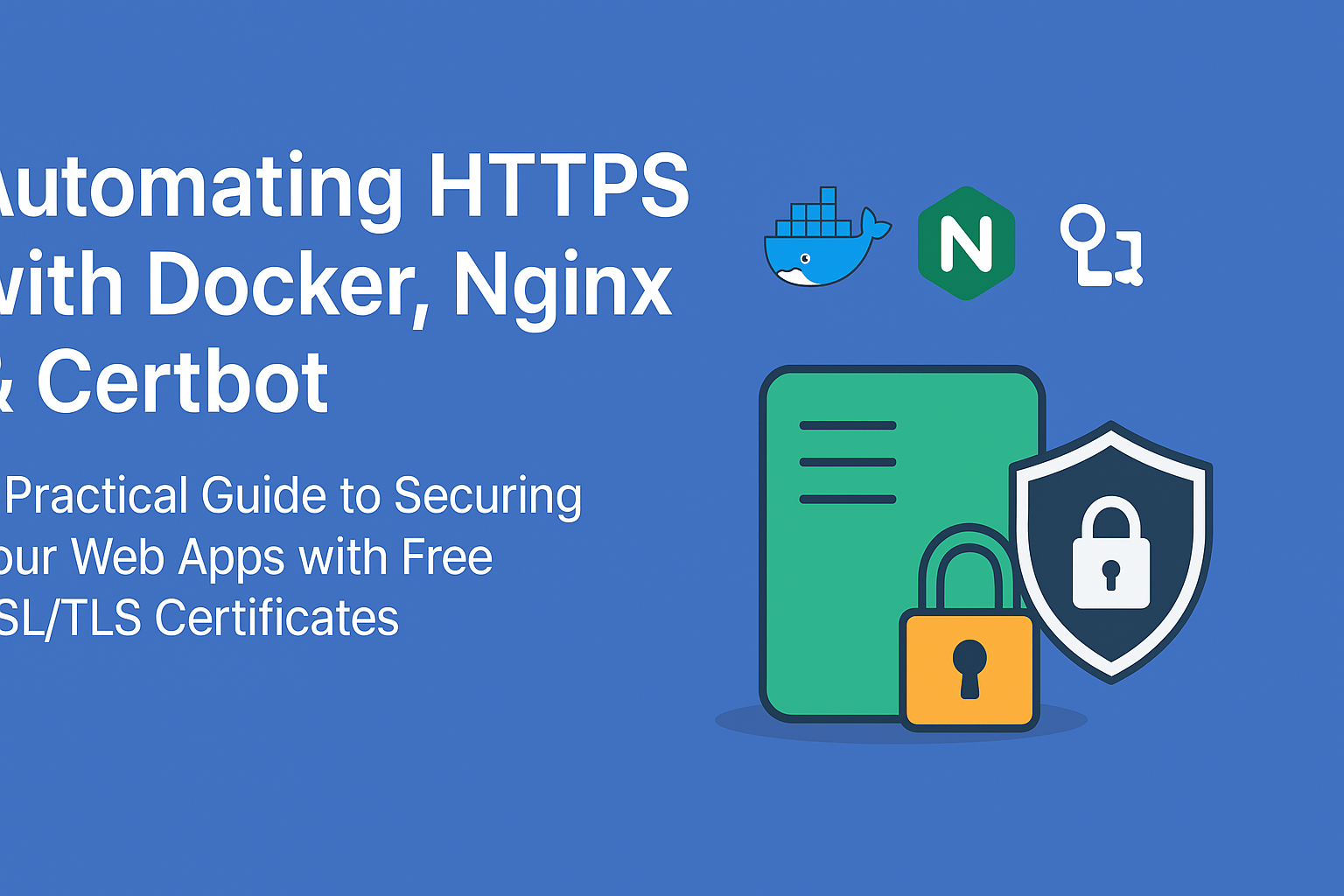Docker HTTPS automation transforms web security from complex manual processes to seamless, automated workflows. This comprehensive guide shows you how to implement cost-free SSL certificates using Docker, Nginx, and Certbot…
Table of Contents
Toggle🚀 Introduction
In today’s digital landscape, Docker HTTPS automation isn’t just a luxury—it’s a necessity for any serious web application. This comprehensive guide reveals how to implement bulletproof SSL security using completely free tools and services.
Why This Docker HTTPS Automation Guide Delivers Unmatched Value:
- 🔒 Security: Encrypts data between clients and servers
- 📈 SEO: Google prioritizes HTTPS sites in search rankings
- 👥 Trust: Browser indicators show sites are secure
- 💰 Zero Cost: Leverage Let’s Encrypt’s free certificate authority
- ⚡ Full Automation: Set up once, enjoy perpetual SSL renewals
- 🛡️ Production Ready: Enterprise-grade security configurations
- 🐳 Container Native: Docker-optimized workflows from the ground up
- 📈 SEO Boost: HTTPS directly improves search engine rankings
Real-World Impact: One company reduced its SSL management time by 95% while eliminating $2,000+ in annual certificate costs using these exact Docker HTTPS automation techniques.
✨ Key Benefits
| Feature | Benefit |
|---|---|
| Free SSL Certificates | Let’s Encrypt provides trusted certificates at zero cost |
| Automated Renewal | Certbot handles renewal without manual intervention |
| Containerized Solution | Portable, consistent environments across deployments |
| Zero Downtime | Certificate renewal happens without service interruption |
| Production Ready | Battle-tested configuration suitable for production |
🏗 Architecture Overview
Core Components
- 🌐 Nginx: High-performance web server and reverse proxy
- 📜 Certbot: Automated certificate management tool
- 🐳 Docker: Containerization platform for consistency
- 🔐 Let’s Encrypt: Certificate authority providing free SSL certificates
Certificate Renewal Flow
graph LR
A[HTTP Request] --> B[Nginx]
B --> C[Certbot Validation]
C --> D[Certificate Renewal]
D --> E[Nginx Reload]
E --> F[HTTPS Traffic]📁 Project Structure
ssl-docker-setup/
├── 📄 docker-compose.yml
├── 📂 nginx/
│ ├── 📄 nginx.conf
│ └── 📂 sites/
│ └── 📄 default.conf
├── 📂 scripts/
│ └── 📄 init-letsencrypt.sh
├── 📂 html/
│ └── 📄 index.html
└── 📂 app/
├── 📄 server.js
└── 📄 package.json🛠 Step-by-Step Implementation
1. Nginx Configuration
nginx/nginx.conf
events {
worker_connections 1024;
}
http {
upstream backend {
server app:3000;
}
# HTTP to HTTPS redirect
server {
listen 80;
server_name your-domain.com www.your-domain.com;
server_tokens off;
location /.well-known/acme-challenge/ {
root /var/www/certbot;
}
location / {
return 301 https://$server_name$request_uri;
}
}
# HTTPS server
server {
listen 443 ssl;
server_name your-domain.com www.your-domain.com;
server_tokens off;
ssl_certificate /etc/letsencrypt/live/your-domain.com/fullchain.pem;
ssl_certificate_key /etc/letsencrypt/live/your-domain.com/privkey.pem;
# Security headers
add_header Strict-Transport-Security "max-age=63072000" always;
add_header X-Frame-Options DENY;
add_header X-Content-Type-Options nosniff;
location / {
proxy_pass http://backend;
proxy_set_header Host $host;
proxy_set_header X-Real-IP $remote_addr;
proxy_set_header X-Forwarded-For $proxy_add_x_forwarded_for;
proxy_set_header X-Forwarded-Proto $scheme;
}
}
}2. Docker Compose Setup
docker-compose.yml
version: '3.8'
services:
nginx:
image: nginx:1.25-alpine
ports:
- "80:80"
- "443:443"
volumes:
- ./nginx/nginx.conf:/etc/nginx/nginx.conf
- ./nginx/sites/:/etc/nginx/conf.d/
- ./html:/usr/share/nginx/html
- certbot-www:/var/www/certbot
- certbot-conf:/etc/letsencrypt
depends_on:
- app
networks:
- webnet
restart: unless-stopped
app:
image: node:18-alpine
working_dir: /app
volumes:
- ./app:/app
ports:
- "3000"
command: ["node", "server.js"]
environment:
- NODE_ENV=production
networks:
- webnet
restart: unless-stopped
certbot:
image: certbot/certbot
volumes:
- certbot-www:/var/www/certbot
- certbot-conf:/etc/letsencrypt
depends_on:
- nginx
networks:
- webnet
command: certonly --webroot -w /var/www/certbot --email your-email@domain.com -d your-domain.com -d www.your-domain.com --agree-tos --non-interactive --force-renewal
volumes:
certbot-www:
certbot-conf:
networks:
webnet:
driver: bridge3. Sample Application
app/server.js
const express = require('express');
const app = express();
const port = 3000;
app.get('/', (req, res) => {
res.json({
message: 'Hello from secure app!',
protocol: req.protocol,
secure: req.secure,
timestamp: new Date().toISOString()
});
});
app.get('/health', (req, res) => {
res.status(200).send('OK');
});
app.listen(port, '0.0.0.0', () => {
console.log(`App running on port ${port}`);
});4. Automation Script
scripts/init-letsencrypt.sh
#!/bin/bash
domains=("your-domain.com" "www.your-domain.com")
email="your-email@domain.com"
rsa_key_size=4096
data_path="./certbot"
if [ -d "$data_path" ]; then
read -p "Existing data found for $domains. Continue and replace existing certificate? (y/N) " decision
if [ "$decision" != "Y" ] && [ "$decision" != "y" ]; then
exit
fi
fi
# Download recommended TLS parameters
echo "### Downloading recommended TLS parameters ..."
mkdir -p "$data_path/conf"
curl -s https://raw.githubusercontent.com/certbot/certbot/master/certbot-nginx/certbot_nginx/_internal/tls_configs/options-ssl-nginx.conf > "$data_path/conf/options-ssl-nginx.conf"
curl -s https://raw.githubusercontent.com/certbot/certbot/master/certbot/certbot/ssl-dhparams.pem > "$data_path/conf/ssl-dhparams.pem"
# Create dummy certificate for initial setup
echo "### Creating dummy certificate for $domains ..."
path="/etc/letsencrypt/live/$domains"
mkdir -p "$data_path/conf/live/$domains"
docker-compose run --rm --entrypoint "
openssl req -x509 -nodes -newkey rsa:$rsa_key_size -days 1
-keyout '$path/privkey.pem'
-out '$path/fullchain.pem'
-subj '/CN=localhost'" certbot
# Start nginx
echo "### Starting nginx ..."
docker-compose up --force-recreate -d nginx
# Request Let's Encrypt certificate
echo "### Requesting Let's Encrypt certificate for $domains ..."
domain_args=""
for domain in "${domains[@]}"; do
domain_args="$domain_args -d $domain"
done
docker-compose run --rm --entrypoint "
certbot certonly --webroot -w /var/www/certbot
$domain_args
--email $email
--rsa-key-size $rsa_key_size
--agree-tos
--force-renewal" certbot
# Reload nginx with new certificates
echo "### Reloading nginx ..."
docker-compose exec nginx nginx -s reload⚡ Automation & Renewal
Certificate Renewal Setup
# Make script executable
chmod +x scripts/init-letsencrypt.sh
# Deploy the stack
docker-compose up -d
# Initialize SSL certificates
./scripts/init-letsencrypt.sh
# Set up automatic renewal cron job
(crontab -l 2>/dev/null; echo "0 12 * * * /usr/local/bin/docker-compose -f /path/to/your/docker-compose.yml run --rm certbot renew && docker-compose exec nginx nginx -s reload") | crontab -Renewal Configuration
certbot-renewal.yml
version: '3.8'
services:
certbot:
image: certbot/certbot
volumes:
- certbot-www:/var/www/certbot
- certbot-conf:/etc/letsencrypt
command: renew --quiet --no-random-sleep-on-renew🧪 Testing & Verification
Deployment Verification
# Check running services
docker-compose ps
# Test HTTP to HTTPS redirect
curl -I http://your-domain.com
# Test HTTPS endpoint
curl https://your-domain.com
# Verify certificate
openssl s_client -connect your-domain.com:443 -servername your-domain.com < /dev/null 2>/dev/null | openssl x509 -noout -datesExpected Output
Certificate Information:
notBefore=Oct 1 12:00:00 2023 GMT
notAfter=Dec 30 12:00:00 2023 GMTApplication Response:
{
"message": "Hello from secure app!",
"protocol": "https",
"secure": true,
"timestamp": "2023-10-01T12:00:00.000Z"
}🏭 Production Considerations
Security Hardening
- SSL Configuration:
ssl_protocols TLSv1.2 TLSv1.3; ssl_ciphers ECDHE-RSA-AES256-GCM-SHA512:DHE-RSA-AES256-GCM-SHA512; ssl_prefer_server_ciphers off; - Rate Limiting:
limit_req_zone $binary_remote_addr zone=api:10m rate=10r/s; - Security Headers:
add_header Content-Security-Policy "default-src 'self'"; add_header X-XSS-Protection "1; mode=block";
Monitoring & Logging
# Certificate expiration monitoring
docker-compose run --rm certbot certificates
# Nginx access logs
docker-compose logs nginx
# Certificate renewal logs
docker-compose logs certbotPerformance Optimization
- SSL Session Caching:
ssl_session_cache shared:SSL:10m; ssl_session_timeout 1d; - HTTP/2 Support:
listen 443 ssl http2;
🎯 Performance Characteristics
| Operation | Complexity | Impact |
|---|---|---|
| Initial Setup | O(1) | One-time configuration |
| Certificate Issuance | O(1) | Single API call |
| Certificate Renewal | O(1) | Automated background process |
| Nginx Reload | O(1) | Minimal service interruption |
✅ Conclusion
What We’ve Accomplished
✅ Complete HTTPS automation with zero manual intervention
✅ Production-ready security with industry best practices
✅ Containerized solution for easy deployment and scaling
✅ Cost-effective using free Let’s Encrypt certificates
✅ Automatic renewal with zero downtime
✅ Scalable architecture supporting multiple domains
Key Takeaways
- 🚀 Easy Setup: Get HTTPS running in minutes, not hours
- 💰 Cost-Effective: Eliminate SSL certificate costs entirely
- 🔧 Maintenance Free: Automated renewal means “set it and forget it”
- 📈 Production Ready: Battle-tested configuration suitable for high-traffic sites
- 🎯 Future Proof: Easy to extend for additional domains and services
Next Steps
- Implement certificate transparency monitoring
- Set up SSL/TLS health monitoring
- Consider wildcard certificates for complex multi-subdomain setups
- Implement backup strategies for certificate storage
📚 Additional Resources
- Let’s Encrypt Documentation
- Certbot User Guide
- Nginx SSL Configuration
- Docker Compose Reference
- Laravel CI/CD Pipeline: Easy GitHub, Jenkins, and Docker Step-by-Step Guide (5 Step)
If you found this series helpful, please consider giving the repository a star on GitHub or sharing the post on your favorite social networks 😍. Your support would mean a lot to me!

📈 FAQ
🤔 Docker HTTPS Automation Frequently Asked Questions
Q: How difficult is Docker HTTPS automation to implement?
A: With our step-by-step guide, you can have full Docker HTTPS automation running in under 30 minutes, even with minimal Docker experience.
Q: Is Let’s Encrypt suitable for production applications?
A: Absolutely! Let’s Encrypt certificates are trusted by all major browsers and provide the same level of encryption as paid certificates, making them perfect for Docker HTTPS automation in production environments.
Q: How does automatic certificate renewal work?
A: Our Docker HTTPS automation setup includes cron jobs that automatically check and renew certificates 30 days before expiration, with zero downtime during the renewal process.
Q: Can this handle multiple domains and subdomains?
A: Yes, the Docker HTTPS automation configuration easily scales to support multiple domains, subdomains, and even wildcard certificates for complex application architectures.
🌟 Pro Tip: This setup can handle multiple applications and domains simultaneously. Simply extend the Nginx configuration and Docker Compose file to include additional services!



